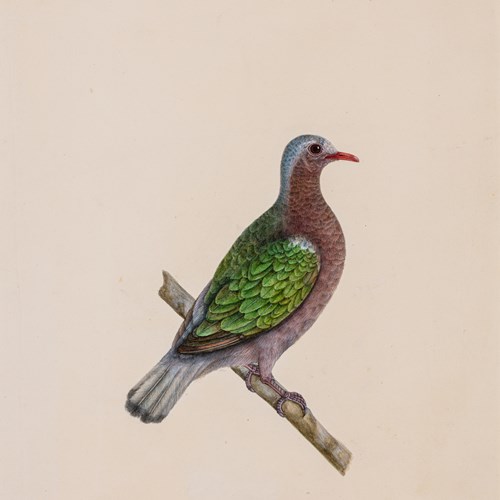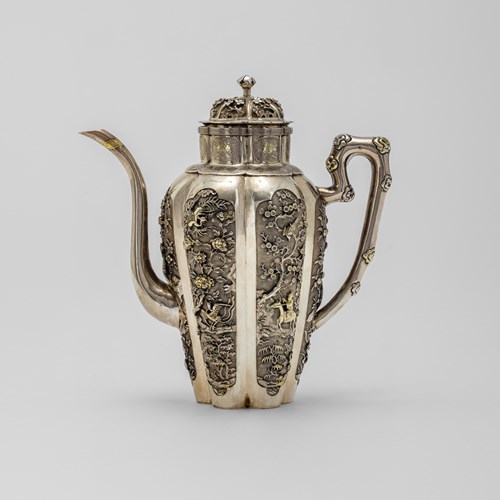A Study of a Pair of Sunbirds
Date c.1800
Period Early 19th century
Origin Calcutta, India
Medium Oil on canvas
Dimension 38.5 x 24 cm (15¹/₈ x 9¹/₂ inches)
The bird at the top of the branch may be a female purple sunbird, or another member of the nectariniidae (sunbird) family. The head and back are a combination of moss and olive tones, with paler greens around the edges of the feathers. A darker strip reaches from the crown along the upper back and the throat is a pale yellow. The wings, lower back and tail feathers are an exquisitely rich forest green. There is a softness to the feathers, creating a sumptuous, velvety quality to the wings.
There are fifteen species of sunbirds in India which inhabit deciduous and dry forests, scrubland and gardens. These vocal birds congregate in garrulous groups, where they are known to fend off much larger birds. Despite eating some insects and berries, sunbirds primarily feed on nectar. Their curved beaks enabled them to extract nectar with expert precision and they are invaluable pollinators for certain plant species.
In the present study it is the bird’s plumage that so captivates the viewer. The employment of precision shading is exceptional, with paler tones used to demarcate the edges of the feathers and deep hues providing body. Both studies exhibit a wonderfully harmonious relationship between rich colours, depth and texture. Not only are the sunbirds exquisitely beautiful, but their glistening plumage also has a highly tactile quality, truly bringing these spirited little birds to life.
For additional ornithological studies made for Lord Valentia, see Sotheby’s Sven Gahlin Collection Lot 36 a drawing of a bustard, and Lot 37 a watercolour of a crow-pheasant, both made for Lord Valentia; Sotheby’s, London, 31 May 2011, The Stuart Cary Welch Collection, Part Two, lot 115; see also Welch 1976, no.26; Welch 1978-I, nos.18a-c.and Leach 1995, no.7.96, pp.760-2. For two bird studies donated by Viscount Valentia to Lord Wellesley, see British Library in London (Wellesley Collection, NHD 29, vol. iv, f.21,27)
Literature
Bikram Grewal et al. 2016. Birds of India - A Pictorial Field Guide. Om Books International.
Stock no.: A5491
Date: c.1800
Period: Early 19th century
Origin: Calcutta, India
Medium: Oil on canvas
Dimension: 38.5 x 24 cm (15¹/₈ x 9¹/₂ inches)
Provenance:
It is highly likely that the work was commissioned by George Annesley, 2nd Earl of Mountnorris and Viscount Valentia (1769-1844), during his visit to Calcutta in 1803. Appearing on the current work, An Emerald Dove and A Caspian Tern, the ink used on a small stamp on the recto left-hand side exactly matches that used for Viscount Valentia’s personal seal on four other works in the present collection; see An Ashy Drongo, A Bronzed Drongo, A Crimson-Browed Finch and A Small Buttonquail.
George Annesley, 2nd Earl of Mountnorris and Viscount Valentia (1769-1844), was a passionate amateur naturalist with a particular interest in ornithology. Following a career in the army, he travelled to India in 1802 where, inspired by his encounters with professional botanists and zoologists, he commissioned a number of natural history paintings.
During his four-month residency with Saadat Ali Khan, Nawab of Oudh (r. 1798-1814), the Viscount was much enthused by the ruler’s additions to his ornithological collection; “he sent people into his woods to bring me rare birds and plants; he laid a dawk two hundred miles to bring them down to me in a state of perfection.” (Viscount Valentia, 1809, p. 172.)
In 1803 he stayed with Lord Wellesley (the elder brother of the first Duke of Wellington) and visited his menagerie in Barrackpore, Calcutta. Viscount Valentia gifted Wellesley two bird studies from his collection, now in the British Library, London (see M. Archer, Natural History Drawings in the India Office Library, London, 1962, p. 96). The works bear his personal Indian seal, “The Right Honourable Lord Bahadur Viscount Valentia.”
Returning to England in 1806, the Viscount became a member of parliament and wrote a three- volume series chronicling his travels, Voyages and Travels to India, Ceylon and the Red Sea, Abyssinia and Egypt in 1802-06. Published in 1809, the books were illustrated by his draughtsman and secretary Henry Salt. Continuing his interest in the natural world, Annesley became a member of the Royal Society and subsequently his collection has become the subject of an important series of natural history studies, celebrating India’s rich ecological biodiversity.
Of the current series of paintings, four bear the Viscount’s personal Indian seal, “The Right Honourable Lord Bahadur Viscount Valentia 1217 (1802-3)”, while three others have a seal in exactly the same ink as the works with a personal seal. Considering this and that the paintings display such a great likeness to one another, it is highly probable that they were commissioned by the Viscount and undertaken by the same artists. Drawing upon Mughal traditions of exceptionally intricate detail, rich colouration and masterful observation, Viscount Valentia’s artists successfully united this with European scientific taxonomy; achieving a sense of harmony between the romantic and the rational. Charming, informative and highly decorative, these works are a valuable example of the finest early nineteenth century Indian ornithological painting.
More artworks from the Gallery









